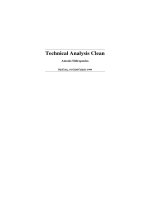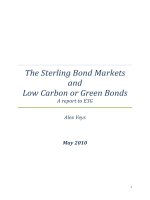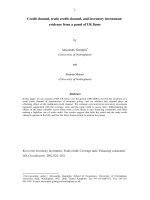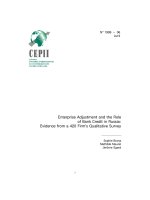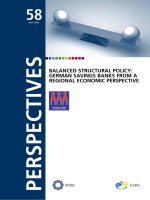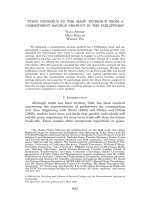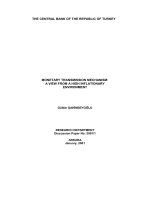Richer wiser happier william green
Bạn đang xem bản rút gọn của tài liệu. Xem và tải ngay bản đầy đủ của tài liệu tại đây (3.57 MB, 304 trang )
More Praise for RICHER, WISER, HAPPIER
“Endlessly fascinating… Richer, Wiser, Happier is going to be a classic.”
—Guy Spier, CEO of Aquamarine Capital and
author of The Education of a Value Investor
“Wonderful… a profound, eloquent, and muchneeded call for a reassessment of how we build our
portfolios and live our lives.”
—Stig Brodersen, cofounder of The Investor’s
Podcast Network and host of the podcast We Study
Billionaires “Highly recommended… a thoroughly
engaging book that is brimming with unique insights
into investing and life.”
—John Mihaljevic, chairman of MOI Global and
author of The Manual of Ideas
“Invaluable… destined to become a timeless classic on lifelong learning, selfimprovement, and becoming the best version of ourselves.”
—Gautam Baid, author of The Joys of Compounding
“Edifying… William Green draws on history, philosophy, and spirituality to
present a meditation on investing. Far more than a book about stock picking,
Richer, Wiser, Happier is the enlightened investor’s guide to life.”
—Nina Munk, author of The Idealist and Fools Rush
In
“Fantastic… accomplishes what few books ever have, which is to show how to be
rational.”
—Saurabh Madaan, deputy chief investment o cer
at Markel Corporation and former senior data
scientist at Google
Thank you for downloading
this Simon & Schuster
ebook.
Get a FREE ebook when you join our mailing list. Plus, get updates on new
releases, deals, recommended reads, and more from Simon & Schuster.
Click below to sign up and see terms and conditions.
CLICK HERE TO SIGN UP
Already a subscriber? Provide your email again so we can register this
ebook and send you more of what you like to read. You will continue to
receive exclusive offers in your inbox.
For Lauren, Henry, Madeleine, and Marilyn
INTRODUCTION
Inside the Minds of the Greatest
Investors
I’ve been obsessed with investing for a quarter of a century. At rst, it seemed an
unlikely passion. I had never taken a class in business or economics. I had no
talent for numbers and no grasp of the esoteric mysteries of accounting. After
leaving Oxford with a degree in English literature, I reviewed novels for
magazines and wrote pro les of fraudsters and murderers. As an aspiring author
with high-minded dreams of literary fame, I found it easy to dismiss Wall Street
as a casino full of crass speculators who cared only about money. When the New
York Times landed on my doorstep, I would jettison the business section
without even glancing at it.
But in 1995, I found myself with a bit of cash to invest—my half of the
proceeds from the sale of an apartment that I owned with my brother. I began to
read incessantly about stocks and funds, eager to increase my modest windfall.
This reawakened in me a gambling streak that had brie y run wild when I was a
teenager in England in the 1980s. At fteen, when I was a student at Eton, I’d
sneak out of school on lazy summer afternoons and spend hours at a local “turf
accountant” near Windsor Castle, betting on horses while my classmates played
cricket or went rowing. I was meant to become a posh English gentleman like
Boris Johnson, Prince William, and six centuries of Etonians before us. Instead, I
had an illegal betting account under the name of Mike Smith.
My interest in horse racing was fueled not by the romance of the sport or the
majesty of the equine form, but by a desire to make money without working. I
took it seriously, jotting down elaborate notes about horses and courses, using
multicolored ink pens to highlight my wins and losses. I ruined my sixteenth
birthday by ghting with my parents over their refusal to buy me a subscription
to Timeform, a pricey system for rating horses. I was outraged that they blocked
this obvious route to untold riches. Shortly afterward, following a string of
disillusioning losses, I renounced racing once and for all.
A decade later, when I began to read about investing, I discovered that the
stock market o ered similar thrills. But the odds of success were much higher.
Stocks struck me as the perfect way to cash in merely by outthinking other
people. Of course, I had no idea what I was doing. But I had one inestimable
advantage. As a journalist, I could indulge my new xation by interviewing
many of the best investors in the business.
In the years that followed, I interviewed a pantheon of investment legends for
Forbes, Money, Fortune, and Time, returning again and again to the same
overarching questions that fascinate me to this day: What principles, processes,
insights, habits, and personality traits enable this tiny minority to beat the
market in the long run and become spectacularly rich? More important, how
can you and I pro t by studying these nancial outliers and reverse engineering
their winning ways? Those questions lie at the heart of this book.
To my delight, many of the investors I encountered were fascinating and
oddly exotic. I ew to the Bahamas to spend a day with Sir John Templeton, the
greatest global stock picker of the twentieth century, who lived in a Caribbean
idyll called Lyford Cay. I traveled to Houston for an audience with Fayez
Saro m, an enigmatic Egyptian billionaire nicknamed the Sphinx. In his o ce,
he displayed paintings by El Greco and Willem de Kooning, along with a fthcentury mosaic oor imported from a Syrian church. I spoke with Mark Mobius
(the Bald Eagle), who ew around the developing world in a Gulfstream jet
adorned with gold-plated xtures and iguana-skin upholstery, purchased from a
Middle Eastern tycoon who had fallen on hard times. I interviewed Michael
Price, a polo-playing centimillionaire who terrorized underperforming CEOs
and came to be known as “the scariest SOB on Wall Street.” I met Helmut
Friedlaender, who had ed from Germany in the 1930s, stopping only to pick
up his teenage sister and buy a hat “because a gentleman does not travel without
a hat.” He drank Château Pétrus, collected precious medieval books, and traded
everything from co ee futures to the Empire State Building. In his nineties, he
told me, “I have lived uproariously.”
It was a priceless education. Jack Bogle, the index fund icon who founded
Vanguard, which now manages $6.2 trillion, talked to me about the formative
investment lessons he’d learned from his mentor and “hero,” a mutual fund
pioneer named Walter Morgan: “Don’t get carried away. Don’t take excessive
risk.… Keep your costs low.” And: “The crowd is always wrong.” As we shall see,
Bogle also explained why “you don’t need to be great” to thrive as an investor.
Peter Lynch, Fidelity’s most famous fund manager, talked to me about how
he’d won by outworking everybody else. But he also spoke about the wild
unpredictability of markets and the need for humility: “You get a lot of A’s and
B’s in school. In the stock market, you get a lot of F’s. And if you’re right six or
seven times out of ten, you’re very good.” Lynch recalled one of his rst failures:
a high- ying apparel business went bust “all because of the movie Bonnie and
Clyde,” which altered women’s fashions so unexpectedly that the company’s
inventory became “worthless.” Ned Johnson, the multibillionaire who built
Fidelity into a behemoth, laughed and told Lynch, “You did everything right.…
Things come out of left eld every now and then.”
In the tumultuous days after 9/11, when nancial markets were su ering
their worst week since the Great Depression, I headed to Baltimore to visit Bill
Miller, who was in the midst of an unprecedented streak of beating the S&P 500
index for fteen years running. We spent a few days together and traveled in his
Learjet, which he’d bought in part so that his 110-pound Irish wolfhound could
y with him. The economy was reeling, war was brewing in Afghanistan, and his
fund had tumbled 40 percent from its peak. But Miller was relaxed and cheerful,
coolly staking hundreds of millions of dollars on beaten-down stocks that
subsequently soared.
One morning, I was standing beside him when he rang his o ce to check in.
The analyst on the other end of the line broke it to him that AES, a stock that
Miller had only just bought, had announced terrible earnings. The stock halved,
costing him $50 million before lunchtime. Miller instantly doubled his bet,
calmly assuming that irrational investors had overreacted to the company’s
dismal news. As he explained to me, investing is a constant process of calculating
the odds: “It’s all probabilities. There is no certainty.”
And then there was Bill Ruane, one of the most successful stock pickers of
his generation. When Warren Bu ett closed his investment partnership in 1969,
he recommended Ruane as a replacement for himself. Until his death in 2005,
Ruane’s Sequoia Fund generated stunning returns. He almost never granted
interviews, but we spoke at length about the four guiding principles he had
learned in the 1950s from “a major star” named Albert Hettinger. “Those simple
rules have been of enormous importance to me,” said Ruane. “They formed the
basis for a large part of my philosophy ever since.… And they are the best advice I
can give people.”
First, warned Ruane, “Do not borrow money to buy stocks.” He recalled an
early experience when, by using leverage, he “took six hundred dollars and
multiplied it many times.” Then “the market cracked” and he was hit so hard
that he sold out and was “back almost to square one.” As he discovered then,
“You don’t act rationally when you’re investing borrowed money.” Second,
“Watch out for momentum.” That’s to say, proceed with extreme caution
“when you see markets going crazy,” either because the herd is panicking or
charging into stocks at irrational valuations. Third, ignore market predictions: “I
rmly believe that nobody knows what the market will do.… The important
thing is to nd an attractive idea and invest in a company that’s cheap.”
For Ruane, the fourth principle was the most important of all: invest in a
small number of stocks that you’ve researched so intensively that you have an
informational advantage. “I try to learn as much as I can about seven or eight
good ideas,” he said. “If you really nd something very cheap, why not put
fteen percent of your money in it?” For regular investors, there are safer paths
to success. “Most people would be much better o with an index fund,” said
Ruane. But for investors aiming to beat the market, concentration struck him as
the smart way to go: “I don’t know anybody who can really do a good job
investing in a lot of stocks except Peter Lynch.”
When we spoke in 2001, Ruane told me that 35 percent of Sequoia’s assets
were riding on a single stock: Berkshire Hathaway. It had fallen out of favor
during the dotcom craze, and Bu ett, its chairman and CEO, was lambasted for
losing his touch. Yet Ruane saw what others missed: “a wonderful company”
with superior growth prospects run by “the smartest guy in the country.”
What I began to understand is that the greatest investors are intellectual
mavericks. They’re not afraid to question and defy conventional wisdom. They
pro t from the misperceptions and mistakes of people who think less rationally,
rigorously, and objectively. In fact, one of the best reasons to study the investors
spotlighted in this book is that they can teach us not only how to become rich,
but how to improve the way we think and reach decisions.
The rewards for investing intelligently are so extravagant that the business
attracts many brilliant minds. But there can also be a devastating price to pay for
being wrong, which is rarely the case for professors, politicians, and pundits.
The stakes involved may explain why the best investors tend to be open-minded
pragmatists who search relentlessly for ways to improve their thinking.
This mindset is embodied by Bu ett’s frighteningly clever partner, Charlie
Munger, who once remarked, “I observe what works and what doesn’t and
why.” Munger, who is one of the central gures in this book, has roamed far and
wide in his quest for better ways to think, borrowing analytical tools from
disciplines as diverse as mathematics, biology, and behavioral psychology. His
role models include Charles Darwin, Albert Einstein, Benjamin Franklin, and a
nineteenth-century algebraist named Carl Gustav Jacobi. “I learned a lot from a
lot of dead people,” Munger told me. “I always realized that there were a lot of
dead people I ought to get to know.”
I’ve come to think of the best investors as an idiosyncratic breed of practical
philosophers. They aren’t trying to solve those abstruse puzzles that mesmerize
many real philosophers, such as “Does this chair exist?” Rather, they are seekers
of what the economist John Maynard Keynes called “worldly wisdom,” which
they deploy to attack more pressing problems, such as “How can I make smart
decisions about the future if the future is unknowable?” They look for
advantages wherever they can nd them: economic history, neuroscience,
literature, Stoicism, Buddhism, sports, the science of habit formation,
meditation, or anything else that can help. Their unconstrained willingness to
explore “what works” makes them powerful role models to study in our own
pursuit of success, not only in markets but in every area of life.
Another way to think about the most skillful investors is as consummate
game players. It’s no coincidence that many top-notch money managers play
cards for pleasure and pro t. Templeton used his poker winnings to help pay for
college during the Depression. Bu ett and Munger are passionate about bridge.
Mario Gabelli, a billionaire fund mogul, told me how he earned money as a poor
boy from the Bronx by playing cards between rounds as a caddy at a fancy golf
club. “I was eleven or twelve,” he recalled, “and everybody thought they could
win.” Lynch, who played poker in high school, college, and the army, told me,
“Learning to play poker or learning to play bridge, anything that teaches you to
play the probabilities… would be better than all the books on the stock market.”
As I’ve come to realize, it’s helpful to view investing and life as games in
which we must consciously and consistently seek to maximize our odds of success.
The rules are elusive and the outcome uncertain. But there are smart ways to
play and dumb ways to play. Damon Runyon, who was besotted with games of
chance, once wrote that “all life is six to ve against.”I Perhaps. But what
captivates me is that Templeton, Bogle, Ruane, Bu ett, Munger, Miller, and
other giants whom we’ll study in the chapters to come have gured out shrewd
ways to stack the odds in their favor. My mission is to show you how.
Consider Ed Thorp, who is probably the greatest game player in investment
history. Before he became a hedge fund manager, he achieved immortality in
gambling circles by devising an ingenious scheme to beat the casino at blackjack.
As Thorp explained to me over a three-hour breakfast of eggs Benedict and
cappuccino, he refused to accept the “conventional belief” that it was
mathematically impossible for players to gain an edge over the dealer. Thorp, the
father of card counting, gave himself an advantage by calculating the change in
probabilities once certain cards were “gone from the deck” and “no longer
available.” For example, a deck packed with aces o ered him better odds than
one without them. When the odds favored him, he bet more; when they favored
the casino, he bet less. Over time, his modest advantage became overwhelming.
Thus, he transformed a loser’s game of luck into a lucrative “game of math.”
For his next trick, Thorp gured out how to beat the casino at roulette. He
and a partner, Claude Shannon, created the rst wearable computer, which
Thorp activated furtively with a big toe inside his shoe. The computer, which
was the size of a cigarette pack, enabled him to “measure the position and
velocity of the ball and rotor very accurately,” so he could predict where the ball
was likely to land. For centuries, roulette was a mug’s game in which players had
no edge, since the ball has an equal chance of falling in each of thirty-eight
pockets. “But by adding some knowledge and some measurement, we get a little
better grasp on the probabilities of what’s going to happen,” said Thorp. “You
won’t get it right every time, but your forecast will be somewhat better than
chance.… So we were turning what seemed like a game of pure chance into a
game where we had an edge. And the edge was provided by the information that
we were adding.”
Unless you own a casino, Thorp’s subversive genius is irresistibly appealing. It
was never the money that excited him so much as the joy of solving “interesting
problems” that all of the experts insisted were insoluble. “Just because a lot of
people say something is true, that doesn’t carry any particular weight with me,”
said Thorp. “You need to do some independent thinking, especially about the
important things, and try to work them out for yourself. Check the evidence.
Check the basis of conventional beliefs.”
As Thorp’s adventures suggest, one critical way to improve our nancial lives
is to avoid games in which the odds are stacked against us. “As far as gambling is
concerned, if I don’t have an edge, I don’t play,” said Thorp. Applying that same
principle, the rest of us would be wise to face reality as honestly as possible; for
example, if my knowledge of technology is imsy or I lack the basic nancial
skills required to value a business, I should resist any temptation to pick
individual tech stocks for myself. Otherwise, I’m like the patsy at the roulette
wheel, hoping that fate will smile kindly upon me despite my delusions. As
Je rey Gundlach, a coldly rational billionaire who oversees about $140 billion in
bonds, remarked to me, “Hope is not a method.”
Another common mistake that tilts the odds against many unsuspecting
investors is to pay lavish fees to mediocre fund managers, stockbrokers, and
nancial advisers whose performance doesn’t justify the expense. “If you’re
paying tolls as you go and trading costs, advisory fees, all kinds of other charges,
you’re swimming against the current,” said Thorp. “If you’re not paying all these
things, you’re swimming with the current.” One obvious way, then, for regular
investors to boost their odds of long-term victory is to buy and hold index funds
that charge minuscule fees: “You don’t have to do any work and you’re ahead of
maybe eighty percent of the people who do otherwise.” An index such as the
S&P 500 will “probably” rise in the long run, added Thorp, driven by the
“expansion of the American economy.” So, unlike gamblers in a casino, “you
have an automatic edge” by merely participating in the market’s upward
trajectory at a minimal cost.
By contrast, Thorp’s hedge fund crushed the indexes over two decades
without a single losing quarter by focusing on more obscure investment
opportunities that “were not well understood.” For example, his exceptional
math skills enabled him to value warrants, options, and convertible bonds with
unrivaled accuracy. Other key characters in this book, such as Howard Marks
and Joel Greenblatt, gained similar advantages by specializing in neglected or
detested niches of the nancial markets. As we shall see, there are many ways to
win, but they all require some form of edge. When I asked Thorp how to tell
whether I have one, he o ered this disconcerting thought: “Unless you have a
rational reason to believe you have an edge, then you probably don’t.”
When my investment journey began twenty- ve years ago, I yearned to be
nancially free and answerable to nobody. The best investors had cracked the
code, which seemed almost magical to me. But what I realize now is that
understanding how these individuals think and why they win can help us
immeasurably in so many ways— nancially, professionally, and personally.
For example, when I asked Thorp how to maximize my odds of a happy and
successful life, he illustrated his characteristic approach by discussing health and
tness. Thorp, who was eighty-four but looked twenty years younger, observed,
“Genetically, you’re dealt certain cards.… You can think of that as chance. But
you have choices about how to play those cards,” including the choice to avoid
cigarettes, have annual medical checkups, keep your vaccinations up-to-date, and
exercise regularly. In his thirties, Thorp was “in terrible shape” and found
himself “gasping for breath” after jogging for a quarter of a mile. So he started
running one mile every Saturday, improving gradually until he completed
twenty-one marathons. He still sees a personal trainer twice a week and walks
three miles a day four times a week. But when someone suggested that he take up
biking, Thorp scrutinized the number of “deaths per hundred million passenger
miles for cycling” and “decided that the risk was too high.”
When I spoke with him again, it was June 2020 and the world was gripped by
a pandemic that had already killed more than one hundred thousand Americans.
Thorp explained how he’d analyzed the mortality data from around the globe,
paying particular attention to “unexplained deaths” that were probably caused
by the virus; how he’d drawn “inferences” from the 1918 u pandemic that had
killed his grandfather; how he’d produced his own estimate of “the true fatality
rate”; and how he’d predicted in early February (before a single death was
recorded in the United States) that the country would lose two hundred
thousand to ve hundred thousand lives to this new coronavirus over the next
twelve months.
Thorp’s methodical analysis of the data enabled his family to take timely
precautions when few Americans—least of all, the nation’s leaders—recognized
the magnitude of the threat. “We prudently put away supplies of all kinds,
including masks,” he said. “It was about a month later that people woke up and
started cleaning out store shelves.” Three weeks before the government declared
a national emergency, Thorp placed himself in isolation at his home in Laguna
Beach and “stopped seeing everybody” except his wife. “There’s no point being
scared,” he told me. But he understood the risks and acted decisively to augment
his odds of survival. Thorp may be the only person I’ve ever met who actually
calculated his own “chance of dying.”II
That mental habit of thinking dispassionately about facts and gures,
probabilities, trade-o s between risk and reward, and the paramount
importance of simply avoiding catastrophe does much to explain how the
savviest investors live long and prosper. As Thorp sees it, every aspect of our
behavior should be guided by an attitude of “generalized rationality.” For
example, he knows that he’s more likely to make bad decisions when he’s “in
emotional mode.” So, if he’s “irritated or mad” at somebody, he takes a step back
and asks himself, “What do you really know? Is your feeling justi ed or not?”
His measured analysis often indicates to him that his adverse reaction was
unwarranted. “We jump to conclusions when we shouldn’t,” he observed. “And
so withholding judgment is, I think, a key element of rational behavior.”
All of this leads me to believe that the true titans of the investment world can
help us to become richer, wiser, and happier. My goal is to show you how they
win both in markets and life by nding countless ways to optimize the odds of
success.
Playing the odds is an extraordinarily e ective way to operate, and it pervades
everything they do, including how they manage their time, how they construct a
calm environment in which to think, whom they hang out with and steer clear
of, how they guard against biases and blind spots, how they learn from mistakes
and avoid repeating them, how they handle stress and adversity, how they think
about honesty and integrity, how they spend money and give it away, and how
they attempt to build lives imbued with a meaning that transcends money.
In writing this book, I’ve drawn deeply from the most important interviews I
conducted in the distant past with many of the world’s best investors. But I’ve
also spent hundreds of hours interviewing more than forty investors speci cally
for this book, reporting everywhere from Los Angeles to London, Omaha to
Mumbai. Between them, the characters you will meet here have overseen trillions
of dollars on behalf of millions of people. My hope is that these extraordinary
investors will enlighten—and enrich—your life. I would bet on it.
CHAPTER ONE
The Man Who Cloned Warren Buffett
How to succeed by shamelessly borrowing other
people’s best ideas
A wise man ought always to follow the paths beaten by great men, and to imitate those
who have been supreme, so that if his ability does not equal theirs, at least it will savor
of it.
—Niccolò Machiavelli
I believe in the discipline of mastering the best that other people have ever gured out.
I don’t believe in just sitting down and trying to dream it all up yourself. Nobody’s
that smart.
—Charlie Munger
It’s 7:00 a.m. on Christmas Day. Mohnish Pabrai steps into a minivan in
Mumbai as the sun rises in the smoggy sky. We drive for hours along the western
coast of India toward a territory called Dadra and Nagar Haveli. Our driver
intermittently executes terrifying maneuvers, swerving wildly between trucks
and buses. I close my eyes and grimace in horror as horns blare on all sides.
Pabrai, who grew up in India before moving to the United States for college,
smiles serenely, always calm in the presence of risk. Still, he concedes, “The
accident rate in India is high.”
It’s a riveting drive, full of mind-bending sights. At one point, we pass a
plump man by the side of the road who’s stacking bricks on top of a skinny
woman’s head so she can carry them. As we drive deeper into the countryside,
we see squat huts covered with grass—structures that seem to belong to another
millennium. Finally, we reach our destination: a rural high school called JNV
Silvassa.
Pabrai, one of the preeminent investors of his generation, has traveled here
from his home in Irvine, California, to visit forty teenage girls. They are part of a
program run by his charitable foundation, Dakshana, which educates gifted
children from disadvantaged families across India. Dakshana is providing these
girls with two years of free schooling to prepare them for the infamously di cult
entrance exam to the Indian Institutes of Technology (IIT), a group of elite
engineering colleges whose graduates are coveted by companies such as
Microsoft and Google.
More than a million students apply to IIT each year, and less than 2 percent
are accepted. But Dakshana has cracked the code. Over twelve years, 2,146
Dakshana scholars have won places at IIT—an acceptance rate of 62 percent.
Pabrai views Dakshana (a Sanskrit word meaning “gift”) as a means of uplifting
the most underprivileged segments of Indian society. Most Dakshana scholars
come from rural families that survive on less than $2 a day. Many belong to lower
castes, including “untouchables,” who have su ered centuries of discrimination.
Whenever Pabrai visits a Dakshana classroom, he breaks the ice by posing the
same mathematical problem. Everyone who has solved it has subsequently won a
place at IIT, so it’s a useful way to gauge the talent in the room. The question is
so hard that almost nobody gets it right, and he expects none of the Silvassa
students to meet the challenge. Nonetheless, he writes the problem in chalk on
the blackboard at the front of the classroom: n is a prime number ≥5. Prove that
n2 -1 is always divisible by 24. Then he leans back in a imsy plastic chair while
the girls attempt to divine the answer.I I wonder what they make of this
amboyant, larger-than-life creature—a tall, burly, balding moneyman with a
luxuriant mustache, who’s dressed in a Dakshana sweatshirt and pink jeans.
After ten minutes, Pabrai asks, “Is anyone close?” A fteen-year-old girl
named Alisa says, “Sir, it’s only a theory.” Her tentativeness instills no
con dence, but Pabrai invites her to the front of the classroom to show him her
solution. She hands him a sheet of white paper and stands meekly before him,
head bowed, awaiting judgment. Above her, a sign on the wall says, in
charmingly garbled English, SO LONG AS YOU HAVE FAITH IN YOU, NOTHING WILL
BE ABLE TO ABSTRACT YOU.
“It’s correct,” says Pabrai. He shakes Alisa’s hand and asks her to explain her
answer to the class. He later tells me that she solved the problem so elegantly that
she could rank in the top two hundred in the IIT exam. Pabrai tells her that she’s
“a sure shot” to get in: “All you have to do is keep working hard.” I subsequently
learn that Alisa is from the Ganjam district in the state of Odisha, one of India’s
poorest districts, and was born into a caste that the government calls Other
Backward Classes. In her previous school, she ranked rst out of eighty students.
Pabrai asks Alisa to pose for a photograph with him. “You will forget about
me,” he jokes, “but then I can tell you, ‘We have the picture!’ ” The girls laugh
delightedly, but I nd it hard not to cry. We have witnessed something magical: a
child plucked from poverty has just proven that she has the mental repower to
propel herself and her family into prosperity. Given the environment in which
she was raised and the odds against her, it’s a kind of miracle.
Later that morning, the students pepper Pabrai with questions. Finally, one
plucks up the courage to ask what everyone must want to know: “Sir, how did
you make so much money?”
Pabrai laughs and says, “I compound money.”
Searching for a way to illustrate the concept, he says, “I have a hero. His name
is Warren Bu ett. Who here has heard of Warren Bu ett?” Not a single hand
goes up. The room is a sea of blank faces. So he tells the students about his
eighteen-year-old daughter, Momachi, and how she earned $4,800 in a summer
job after high school. Pabrai invested that money for her in a retirement account.
He asks the students to calculate what would happen if this modest nest egg was
to grow by 15 percent a year for the next sixty years. “It’s doubling every ve
years. That’s twelve doubles,” he says. “Life is all about doubles.”
A minute later, the students have gured it out: in six decades, when
Momachi is seventy-eight years old, her $4,800 will be worth more than $21
million. There is an air of wonder in the room at the awesome power of this
mathematical phenomenon. “Are you going to forget about compounding?”
asks Pabrai. And forty impoverished teenagers from rural India cry out in
unison, “No, sir!”
How to Turn $1 Million into $1 Billion
Not so long ago, Mohnish Pabrai hadn’t heard of Warren Bu ett, either. Raised
in modest circumstances in India, he knew nothing about investing, Wall Street,
or high nance. Born in 1964, he spent the rst ten years of his life in Bombay
(now Mumbai), where his parents rented a tiny suburban apartment for $20 a
month. They later moved to New Delhi and Dubai.
The family was full of colorful characters. Pabrai’s grandfather was a famous
magician, Gogia Pasha, who toured the world posing as a mysterious Egyptian.
As a boy, Pabrai appeared with him onstage. His role was to hold an egg. Pabrai’s
father, Om Pabrai, was an entrepreneur with an uncanny knack for founding
companies that went bankrupt. Among his many ventures, he owned a jewelry
factory, launched a radio station, and sold magic kits by mail. Like his son, he
was an incorrigible optimist. But his businesses were fatally undercapitalized and
overleveraged.
“I watched my parents losing everything multiple times,” says Pabrai. “And
when I say losing everything, I mean not having enough money to buy groceries
tomorrow, not having money to pay the rent.… I never want to go through that
again, but what I saw is that it didn’t bother them. In fact, the biggest lesson I
learned from them is that I didn’t see them get rattled by it. My father used to
say, ‘You could put me naked on a rock and I will start a new business.’ ”
As a child, Pabrai performed poorly at school, once placing sixty-second in a
class of sixty- ve, and he su ered from low self-esteem. Then, in ninth grade, he
was given an IQ test that changed his life. “I went to the guy who administered
the test and said, ‘What does the result mean?’ He said, ‘Your IQ is at least one
hundred eighty. You’re just not applying yourself.’ It was like someone whipping
a horse and it starts. That was a big turning point. People have to be told they
have something in them.”
After high school, he headed to Clemson University, in South Carolina.
There he discovered the stock market. He took an investing class and averaged
106 percent going into the nal. The professor tried to convince him to switch
his major from computer engineering to nance. “I completely ignored his
advice,” says Pabrai. “My perspective at that time was that all these fuckers in
nance are dumbasses. They don’t know shit. And this super-easy class I’m
taking in investing is one-tenth as hard as my engineering mechanics class.… So
why would I want to go into a eld with these losers?”
After college, Pabrai took a job at Tellabs. Then, in 1990, he launched a
technology consulting company, TransTech, bankrolling it with $70,000 in
credit card debt and $30,000 from his 401(k). Most people couldn’t stomach
that level of risk, but he’s always had a gambling streak. Indeed, we once spent an
entire ight discussing his adventures at the blackjack tables in Las Vegas, where
he doggedly applies “an extremely boring” system developed by a card counter
with a PhD in nance. Pabrai’s game plan is to make $1 million and get banned
from the casinos. By 2020, he’d turned $3,000 into $150,000 and been banned
for life by “one small, seedy casino.”
TransTech thrived, ultimately employing 160 people, and Pabrai set aside $1
million in savings by 1994. For the rst time, he had a war chest to invest. That
year, he bought One Up on Wall Street by Peter Lynch while killing time in
Heathrow Airport. It was there that he rst read about Bu ett. He was
astonished to learn that Berkshire Hathaway’s chairman and CEO had racked
up investment returns of 31 percent annually over forty-four years, starting at
the age of twenty. Thanks to the magic of compounding, this meant that an
investment of $1 in 1950 would have grown to $144,523 by 1994. Pabrai
reached a logical conclusion: Bu ett was not a dumbass.
As a boy, Pabrai had heard a tale about an Indian who supposedly invented
chess. He presented his game to the king, who o ered him a reward. The game
inventor requested one grain of rice for the rst square of his chess board, two
grains for the second square, four for the third, and so on, all the way to the
sixty-fourth square. The king, who was arithmetically challenged, granted the
request. Pabrai, who is not arithmetically challenged, says the king owed
18,446,744,073,709,551,615 grains of rice, now worth around $300 trillion.
Remembering this story, Pabrai grasped instantly that Bu ett had mastered the
game of compounding. In forty-four years, he’d doubled his money eighteen
times and was already well on his way to becoming the richest man on earth.
This set Pabrai thinking. What if he could gure out how Bu ett picked
stocks and could mimic his winning approach? Thus began what Pabrai
describes as a “thirty-year game” to turn his $1 million into $1 billion. “The
driver for me is not to get wealthy,” he says. “The driver is to win the game. It’s
exactly the same driver for Warren, which is to show through the results that I
did the best and I am the best because I played the game by the rules, fair and
square, and I won.”
Pabrai’s approach to the challenge of becoming a billionaire holds important
lessons for us all, not just as investors but in every area of life. He didn’t attempt
to reinvent the wheel by, say, devising a new algorithm to exploit subtle pricing
anomalies in the markets. Instead, he identi ed the most skillful player of this
particular game, analyzed why he was so successful, then copied his approach
with scrupulous attention to detail. Pabrai’s term for this process is cloning. We
could also call it modeling, mimicry, or replication. But the terminology doesn’t
matter. This is a technique for people who care more about winning than
sounding respectable or highbrow.
By cloning Bu ett—and later, his polymathic partner, Charlie Munger—
Pabrai has become one of the leading investors of our time. From 2000 to 2018,
his agship hedge fund returned a staggering 1,204 percent versus 159 percent
for the S&P 500 index. If you had invested $100,000 with him when he started
managing money in July 1999, it would have grown to $1,826,500 (after fees
and expenses) by March 31, 2018.II
Yet Pabrai’s success both as an investor and a philanthropist is built entirely
on smart ideas that he has borrowed from others. “I’m a shameless copycat,” he
says. “Everything in my life is cloned.… I have no original ideas.” Consciously,
systematically, and with irrepressible delight, he has mined the minds of Bu ett,
Munger, and others not only for investment wisdom but for insights on how to
manage his business, avoid mistakes, build his brand, give away money, approach
relationships, structure his time, and construct a happy life.
Pabrai’s commitment to cloning raises an array of provocative questions. Is
originality overrated? Instead of struggling to innovate, should most of us focus
our energy on replicating what smarter and wiser people have already gured
out? If cloning is such a powerful strategy for success, why don’t more people
use it? Are there dangers to cloning? And how can we bene t from it while also
being true to ourselves?
Over the last seven years, I’ve spent a great deal of time with Pabrai. I’ve
joined him on multiple trips to Omaha for Berkshire’s annual meeting; I’ve
interviewed him at his o ce in California; we’ve traveled together for ve days in
India, even sharing a bunk bed on an all-night train ride from Kota to Mumbai;
and we’ve overeaten together everywhere from his local Korean barbecue
restaurant to a roadside shack in Jaipur.
Along the way, I’ve come to appreciate the tremendous power of his method
of reverse engineering, replicating, and often improving on other people’s
successful strategies. Pabrai, the most relentless cloner I’ve ever encountered, has
taken the art of appropriation to such an extreme that, paradoxically, it seems
oddly original. His thinking has had a profound impact on me. In fact, the
overarching purpose of this book is to share what I would call “ideas worth
cloning.”
The Laws of Investing
When Pabrai discovers a subject that fascinates him, he attacks it with obsessive
fervor. In Bu ett’s case, the available resources seemed limitless, including
decades of letters to Berkshire’s shareholders and seminal books such as Roger
Lowenstein’s Buffett: The Making of an American Capitalist. Pabrai devoured it
all. He also began to make a pilgrimage each year to Omaha for Berkshire’s
annual meeting, showing up without fail for more than twenty years.
Eventually, Pabrai would develop a personal relationship with Bu ett.
Through Bu ett, he’d also become friends with Munger, who invites him for
meals at his home in Los Angeles and games of bridge at his club. But in those
early days, Pabrai’s knowledge came entirely from reading. And the more he
read, the more convinced he became that Bu ett, with Munger’s help, had laid
out “the laws of investing,” which are as “fundamental as the laws of physics.”
Bu ett’s style of investing seemed “so simple” and “so powerful” that Pabrai
considered it the only way to invest. But when he studied other money
managers, he was perplexed to nd that almost none lived by Bu ett’s laws. It
was like meeting “an entire set of physicists who don’t believe in gravity.…
Whether you believe in gravity or not, it’s fucking gonna pull you down!”
It was clear to Pabrai that most fund managers owned too many stocks, paid
too much for them, and traded them too often. “These mutual funds are sitting
there with one thousand positions or two hundred positions. How can you nd
two hundred companies that will all double? Then I look at what they own, and
they own things that are trading at thirty times earnings.… I saw that they were
all hosed.”
Pabrai had read a book by the management guru Tom Peters that told a
cautionary tale of two self-service gas stations on opposite sides of the street.
One prospers by providing high-quality service, such as cleaning windshields for
free. The other does the bare minimum. What happens? Its customers inevitably
drift to the better gas station. This error amazed Pabrai, since nothing could have
been easier than simply to copy the superior strategy sitting in plain view.
“Humans have something weird in their DNA which prohibits them from
adopting good ideas easily,” says Pabrai. “What I learned a long time back is,
keep observing the world inside and outside your industry, and when you see
someone doing something smart, force yourself to adopt it.” This sounds so
obvious, even trite. But this one habit has played a decisive role in his success.
So, with the zeal of a true disciple, Pabrai committed to invest “the way
Warren said I should.” Given that Bu ett had averaged 31 percent a year, Pabrai
naively assumed that it shouldn’t be hard to average 26 percent. At that rate, his
$1 million would double every three years and hit $1 billion in thirty years. As a
reminder of this compounding target, his license plate reads COMLB 26. Even if
he missed by a mile, he expected to do ne; if, say, he averaged 16 percent a year,
his $1 million would turn into $85.85 million in thirty years. Such is the glory of
compounding.
Of course, he had no MBA from a fancy school such as Wharton or
Columbia, no quali cation as a certi ed nancial analyst, no experience on Wall
Street. But Pabrai, who regards his entire life as a game, expected his rigorous
application of Bu ett’s methodology to give him an edge over all of the fools
who failed to follow the Sage of Omaha. “I want to play games that I know I can
win,” says Pabrai. “So how do you win the game? You’ve got to play according to
the rules. And the good news is, I’m playing against players who don’t even
fucking know the rules.”
As Pabrai saw it, Bu ett’s approach to stock picking grew out of three core
concepts that he’d learned from Benjamin Graham, the patron saint of value
investing, who taught Bu ett at Columbia and later hired him. First, whenever
you buy a stock, you’re purchasing a portion of an ongoing business with an
underlying value, not just a piece of paper for speculators to trade.
Second, Graham viewed the market as a “voting machine,” not a “weighing
machine,” which means that stock prices frequently fail to re ect the true value
of these businesses. As Graham wrote in The Intelligent Investor,III it’s useful to
think of the market as a manic-depressive who “often lets his enthusiasm or his
fears run away with him.”
Third, you should buy a stock only when it’s selling for much less than your
conservative estimate of its worth. The gap between a company’s intrinsic value
and its stock price provides what Graham called a “margin of safety.”
But what does all of this mean in practical terms? Graham’s insight that Mr.
Market is prone to irrational mood swings has profound implications. For
master investors such as Bu ett and Munger, the essence of the game is to detach
themselves from the madness and watch dispassionately until the bipolar market
provides them with what Munger calls “a mispriced gamble.” There are no
prizes for frenetic activity. Rather, investing is mostly a matter of
waiting for these rare moments when the odds of making money vastly
outweigh the odds of losing it. As Bu ett has said, “You don’t have to swing
at everything—you can wait for your pitch. The problem when you’re a money
manager is that your fans keep yelling, ‘Swing, you bum!’ ”
Sublimely indi erent to the cries of the crowd, Bu ett can twiddle his
thumbs for years. For example, he bought almost nothing from 1970 to 1972
when euphoric investors drove stocks to crazy valuations. Then, when the
market crashed in 1973, he bought a major stake in the Washington Post
Company, which he held for four decades. In his classic article “The
Superinvestors of Graham-and-Doddsville,” Bu ett wrote that the market
valued the company at $80 million when “you could have sold the assets to any
one of ten buyers for not less than $400 million.… You don’t try and buy
businesses worth $83 million for $80 million. You leave yourself an enormous
margin. When you build a bridge, you insist it can carry 30,000 pounds, but you
